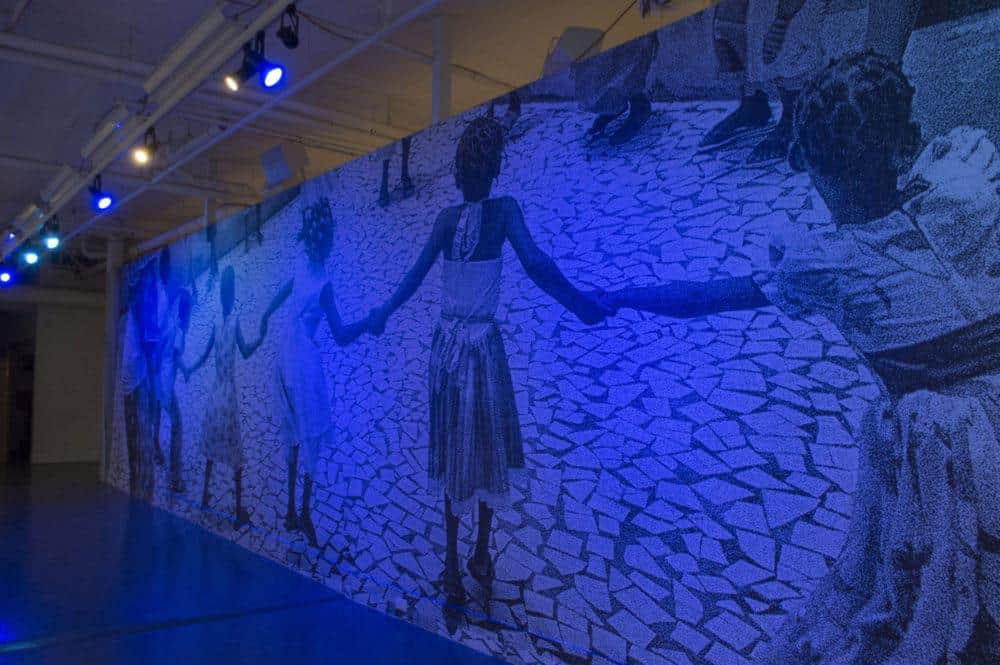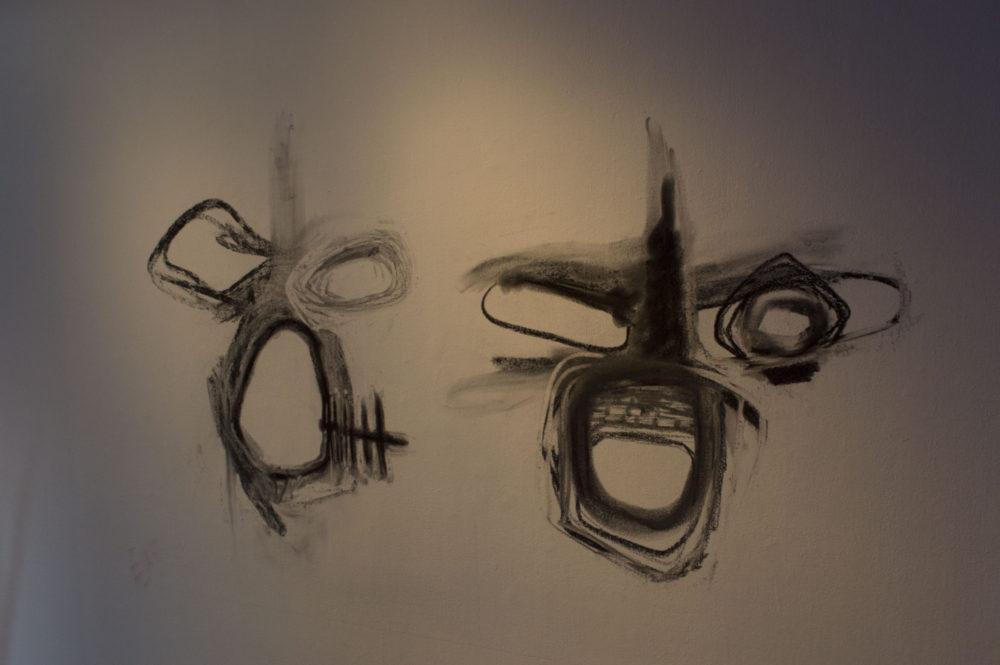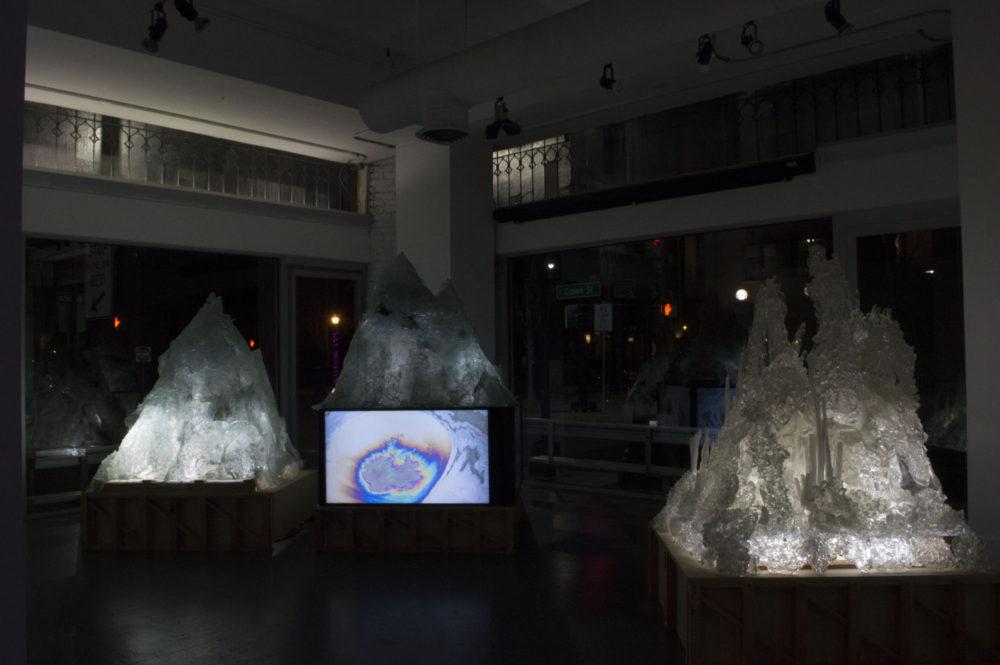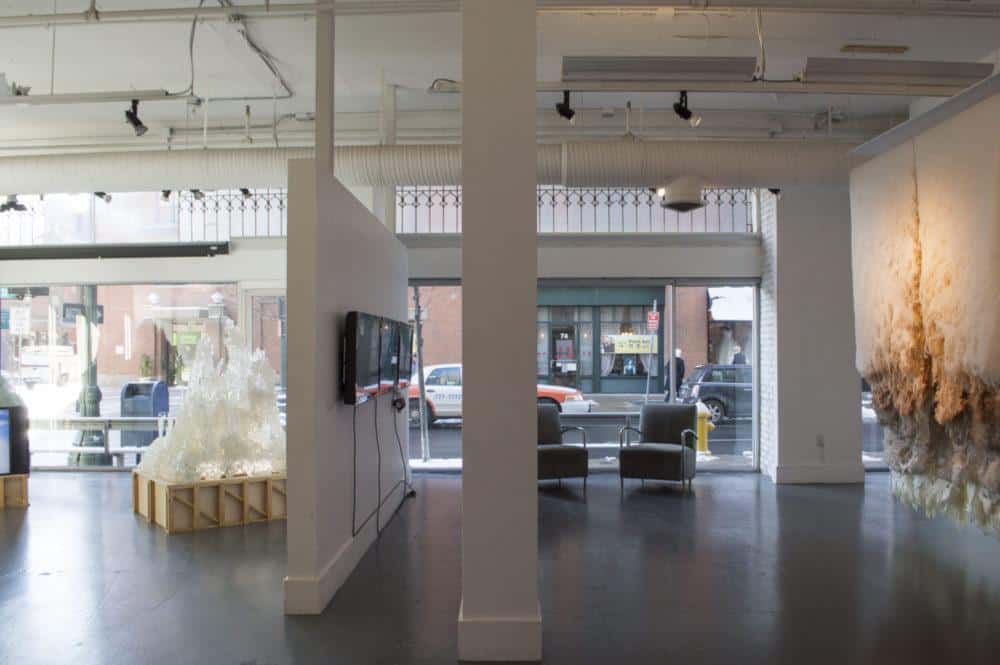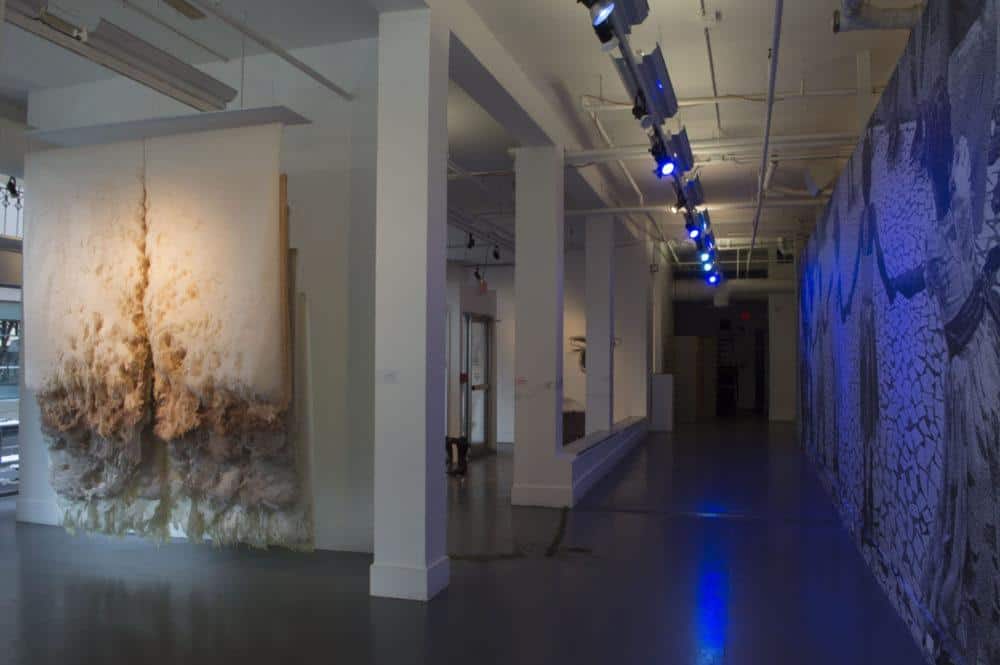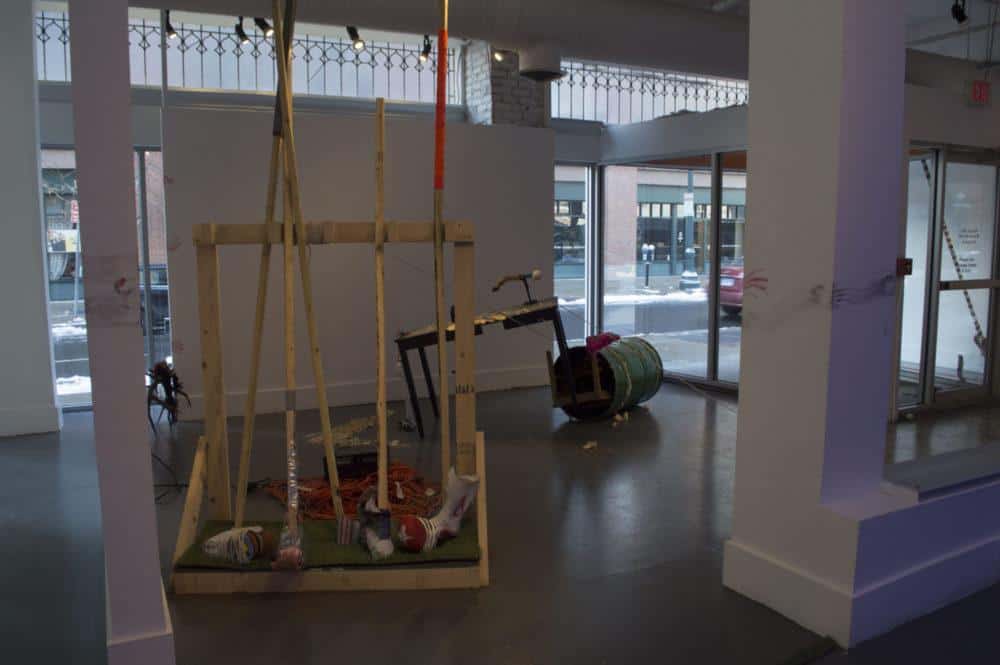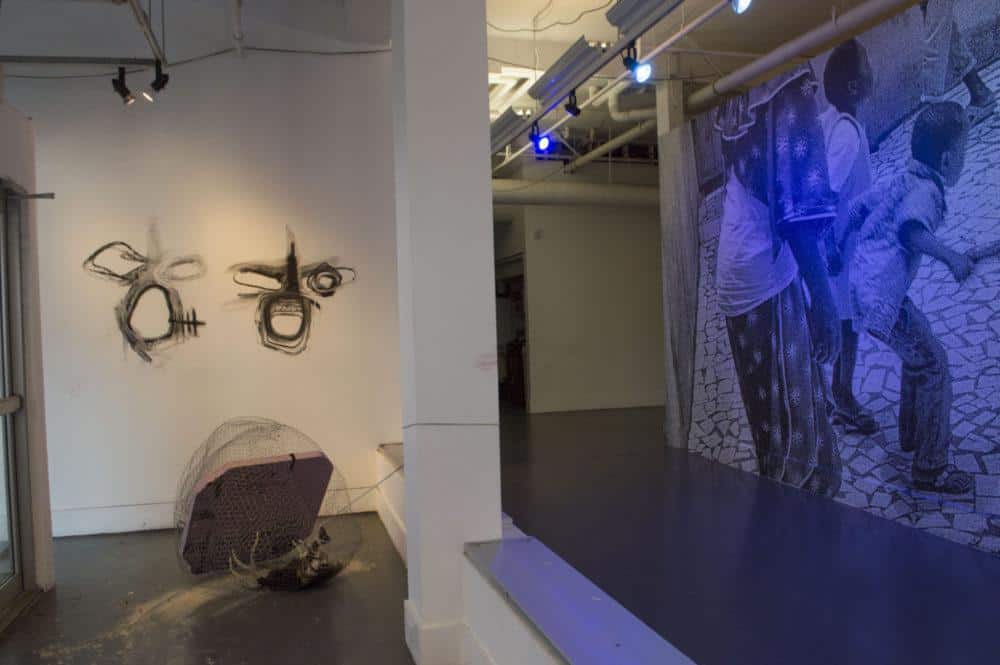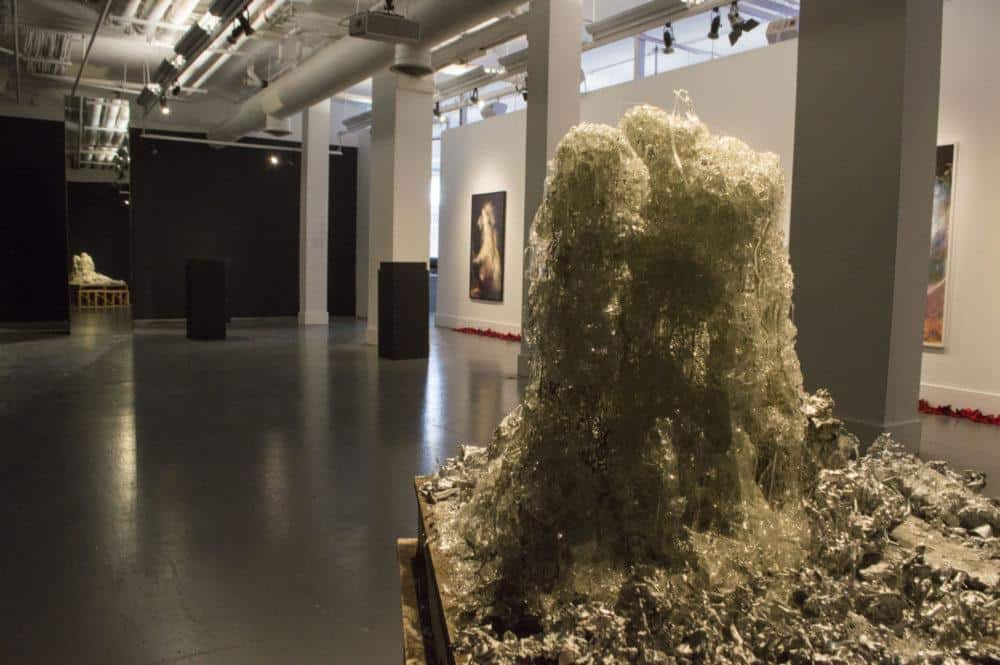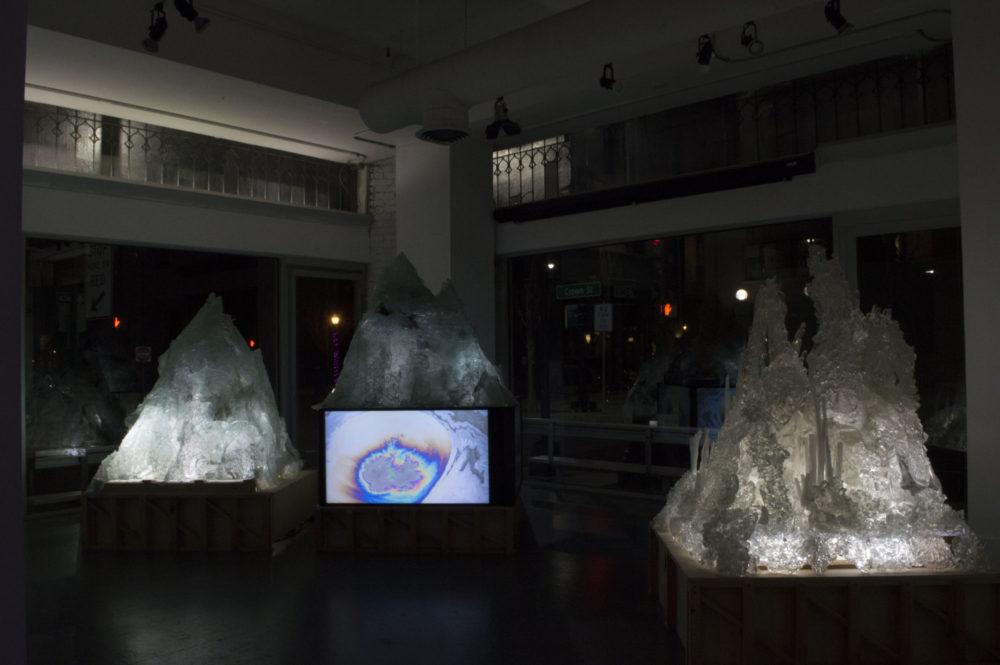
Between Beauty and Decay
Curator: Erin Joyce
December 2, 2017—February 24, 2018
Installation View: Between Beauty and Decay, Artspace New Haven, December 2, 2017-February 24, 2018; Artspace.
Artspace is pleased to present Between Beauty and Decay, a group show that examines humanity in the age of conflict. The artists in this show come from geopolitical backgrounds that deeply inform their work, identifying as American Indian, American, and Middle Eastern. Each use digital media, performance and installation to contemplate their contemporary landscapes, exploring land as a physical, emotional and psychological life-affirming and life-sustaining form. The show confronts with unflinching beauty and terror the realities of what happens when humanity is at odds with the “other” and the natural world.
The exhibition debuts at a time when many populations are living with a great amount of uncertainty and fear. Daily political change, exaggerated opinions, and protest shape and inform our collective health. These artists tackle issues that are porous and specific to this moment, allowing for in depth reads of identity, politicism, power, terror, the end of nature, grief, human suffering and survival. The precarious state of the governmental policy protecting land and land rights, migration patterns and refugee crises, and the reality of the American corporate state are swirling about in a tempest around the the world; the artists in this exhibition deal both will all be explored.
American artist, Andrew Erdos’ work manifests visually, the idea of out of body experience, a breakdown of linear time, and the travel of a soul. Fossil fuels are the reincarnated energy of prehistoric life. They have been the catalyst for a dramatic human evolution and the conclusion of the Holocene Epoch. New work which combines shattered glass mountains, video projection, and television monitors, reflects upon these system breakdowns and the beauty that is emitted through horrific processes. It is an allegorical lens through which to view humanities dependence on oil, the wondrous bounty and innovation that fossil fuels have allowed humanity to achieve, which concurrently and adversely has created systemic manifestations of environmental and social violence, as well as environmental racism. The video is unaltered and minimally edited footage of the Newtown Creek, directly across the street from Erdos’ studio in Brooklyn. Erdos’ piece will be installed as a two-channel video of the same file. The piece will be projected full-bleed onto the ceiling as well as the floor, sandwiching the viewer in the middle of the piece, enveloping them into the ethos of the work.
Expounding more on psychological effects of conflict, and the notions of post- traumatic stress, is the work of Basma Al Sharif. Deep Sleep is a hypnosis-inducing pan-geographic shuttle built on brainwave generating binaural beats. The film takes us on a journey through the sound waves of Gaza to travel between different sights of modern ruin. From the ruins of an ancient civilization embedded in a modern civilization (Athens), to the derelict buildings of anonymous sites (Malta), and a site that is post-civilization (the Gaza Strip). Shot while under self-hypnosis, the artist’s performance-film asks us to move from the corporeal self to the cinema space in a collective act of bilocation that transcends the limits of geographical borders, time and space.
New Haven based artist Kim Weston, who is of African American and Seminole descent, uses time lapsed photographic techniques to capture haunting and metaphysical images from powwows, giving movement to a static image. The work is powerful, visually and conceptually, looking at Indigenous survivance after 500 years of colonial occupation. Jetsonorama will create a 40 ft. mural in the interior of the galley, which documents life on the Navajo Reservation in North Eastern Arizona. New installation work created for the exhibition by Nicholas Galanin, will dig deeper into the Indigenous psyche, illustrating the effects of energy extraction, consumption, and treaty violations, with a subtext of abuses of power from the political realm and the police. The exhibition will also feature new work by Muskogee Creek artist Starr Hardridge, known for his incorporation of Indigenous dialogues and aesthetics into a pointillist fashion, will inspect energy extraction and the consequences of environmental injustice. Modoc/Klamath artist, Natalie Ball creates installation works which consist of animal material, dirt, plant material, and textile; the majority of which she has sourced in and around her ancestral homeland of Southern Oregon and Northern California. Ball reacts to fractured narratives of Indigeneity, breaking false stereotypes, and rebuilding new dialogues on race, identity, place making, and social structures. Additionally, a arresting paper installation by Julie Pereia looks at organic breakdowns, life-cycles, and ceremony.
Artists Include: Basma Al Sharif, Natalie Ball (Modoc and Klamath), Andrew Erdos, Nicholas Galanin (Tlingit/Aleut), Starr Hardridge (Muskogee Creek), Jetsonorama, Julie Pereira, and Kim Weston (Mohawk).
About the Curator
Erin Joyce is the Fine Arts Curator at Heard Museum, an art critic, and scholar of contemporary art. This exhibition represents the next step in the research-based practice, which focusing on contemporary histories of Indigenous North American politics, the politics of the Middle East and North Africa and their diaspora, and U.S. land rights and environmental justice. Her recent exhibition, My Country Tis of Thy People, You’re Dying (2017) explored unsanctioned tribal land sales, Indigenous sovereignty, and history of place.
She holds a BA in the History of Art from the University of North Texas, studied contemporary art at Sotheby’s Institute of Art London, and received her MA in Museum Studies from Johns Hopkins University. Joyce’s projects include exhibitions at Radiator Gallery in New York, IAIA Museum of Contemporary Native Art in Santa Fe, New Mexico, WAAS Gallery in Dallas, LIGHT YEAR in Brooklyn. The-Contemporary in Monterey, California, the Museum of Northern Arizona, and the Coconino Center for the Arts.
This exhibition comes to us as part of Artspace’s annual Emerging Guest Curator program. Each year, Artspace invites emerging curators to submit a proposal/concept and supports the selected project with a modest exhibitions budget. Artspace also arranges an open call for Connecticut artists to be included in the exhibition.
